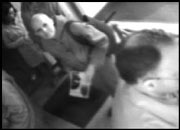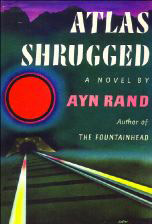First, a few words about cameras: They were everywhere. The house was bugged, tapped, taped, wired, plugged-in, and buzzing. There were small electric eyes in the corners and peering up from the floorboards. There was the face of a camcorder obscuring the face of the man who was pointing it at you, and there was no way of knowing whether you were being recorded or being watched live, in another room, right now. It took organizers two and a half weeks to rig the house with fiber optics: just cold cords strung through a cold house, powered by electricity sucked out of the walls, but the feeling was that the house was a live and unblinking being; a suspicious, self-monitoring organism. The house, and everyone in it, had the jitters.
A warning and, by implication, a somewhat unsettling assurance had been posted on the porch. The notice granted Richard Hugo House “authority and permission” to photograph and record visitors, to copyright such photos and recordings, and to use, reuse, publish, and republish everything. In other words, the sign said: Are you ready to be manipulated? Are you prepared to be used? Perhaps it’s a measure of the appeal of this idea that attendance was underwhelming—forget about a house, the audience could scarcely fill a foyer.
A “cultural inquiry” is difficult to define—let alone sell tickets to. Though there were things worth seeing. Events carried off by individuals carried the most punch. (The three panel discussions I saw were, respectively, digressive, didactic, or dull. The didactic one particularly irritated me: The general consensus held by contributors to Tablet newspaper is that the advent of the QFC club card is a signal of impending apocalypse.)
Jonathan Lethem read a strange piece of science fiction he wrote in 1998, whose plot concerns a “one-way permeable barrier.” The audience was encouraged to ask questions as he read—to zoom in for clarity, to hear passages again, to have things explained. When a character in the story ate a sandwich on the roof of the car, someone in the audience blurted out, “What kind of car?” Someone else said, “What kind of sandwich?” Lethem, who had answers for most things, admitted, “There are some things I don’t know.”
Saturday afternoon, Brian Goedde delivered a smart, not-quite-melancholy monologue on his brief stint as a security guard at an art museum, where “on an ideal day, there’s no reason to even be there.” The function of the security guard goes beyond security, Goedde argued; the guard influences that atmosphere of consumption (inspiring visitors to stand “with a refined posture”). At the same time, paradoxically, the guard feels marginalized (“Constantly being around art,” Goedde said archly, “did not inspire the artist in me”). Goedde also mentioned, though never sufficiently explored, the extent to which visitor’s impressions of art are formed by the adjacent text cards—a discreet method of, as he described it, dictating thought. Goedde’s conclusions about day-to-day museum surveillance were, if nothing else, clarifying: “Everything about surveillance is riveting except for the act itself.”
Although “riveting” would best describe Frances McCue’s lecture, “Surveillance and Abduction.” McCue began with a cue from the confessional poets (after sharing a Sylvia Plath poem, she said, “I want to show you a more subtle approach [to confessional poetry] by—believe it or not—Anne Sexton”). She then, seamlessly, devolved into a personal confessional narrative about being a stalking victim that so perilously steered into the trappings of coincidence and paranoia that I thought, surely, it was an artful fabrication. (Terrifyingly, I learned later, it was not.) McCue deftly linked her own fears with those implicit in the work of Plath and Sexton, placing her personal life in the tradition of confessional literature. Her unnerving conclusion: She will regain the upper hand only by identifying with her stalker. “I can’t stand the idea of being watched,” she said, “unless I’m watching who’s watching me.”
The images collected on the house’s surveillance cameras—36 hours of footage—were edited and shown, in the last event, as a 15-minute montage that was funny and interesting so long as you find images of people surreptitiously scratching themselves funny and interesting. The tension that sustained it, for me (and no doubt everyone else), was wondering whether I would appear in it—with a finger jammed up a nostril, indisposed, or otherwise. I must not have done anything very provocative: I didn’t make the cut.







